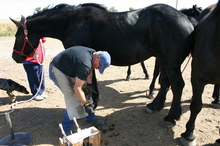The study, conducted by The University of Nottingham School of Veterinary Medicine and Science, and reported by Veterinary Practice News, found that excessive grooming of fingernails and toenails could lead to serious nail conditions, a finding that can be applied to farm animals and horses.

A farrier trimming horse's hoofs
Specifically, physics reveals why/how nails/hoofs adhere strongly, yet grow smoothly; why hoof/claw/nail growth rates are similar across species; and how poor trimming can potentially cause damage.
The study focused on the physics of human nail conditions and may bring a new focus on disease in the hoofs of horses and farm animals. Researchers from The University of Nottingham School of Veterinary Medicine and Science devised equations to identify the physical laws that govern nail growth, and used them to shed light on the causes of some of the most common nail problems, such as ingrown toenails, spoon-shaped nails and pincer nails.
Regular poor trimming can tip the fine balance of nails, causing residual stress to occur across the entire nail, the study revealed. This residual stress can promote a change in shape or curvature of the nail over time which, in turn, can lead to serious nail conditions, the study further noted.
âSimilar equations can be determined for conditions of the hoof and claw and applied to farm animals such as sheep, cattle or horses and ponies,â said Dr. Cyril Rauch, a physicist and applied mathematician. âAt a time when securing food across the world is important, a better understanding of the physics of hoof/claw has never been so essential to maintain the health of livestock and to sustain agriculture and food production.â
Specifically, physics reveals why/how nails/hoofs adhere strongly, yet grow smoothly; why hoof/claw/nail growth rates are similar across species; and how poor trimming can potentially cause nail damage.
In the study, the researchers focused specifically on human ingrown toenails. When devising their equations, the researchers accounted for the strong adhesion of nails to their bed through tiny, microscopic structures, which allow the nail to slide forwards and grow in a âratchet-likeâ fashion by continuously binding and unbinding to the nail.
By also taking into account the mechanical stresses and energies associated with the nail, the researchers came up with an overall nail shape equation.
The equation showed that when the balance between the growth stress and adhesive stress is brokenâif a nail grows too quickly or slowly, or the number of adhesive structures changesâa residual stress across the entire nail can occur, causing it to change shape over time.
Humans, especially ânail beauty fanaticsâ who trim their nails on a daily basis, are urged to go for straight or parabolic edges in order to avoid the imbalance of stresses which âcould lead to a number of serous conditions.â
These findings can be applied to farm animals and conditions associated with their hoofs, according to Rauch.
âI believe that physics can make a difference by promoting a new type of evidence-based veterinary medicine and help the veterinary and farrier communities by devising trimming methods to alleviate pain and potentially remove the cause of serious conditions,â Rauch said.
The study was published in the journal Physical Biology.
